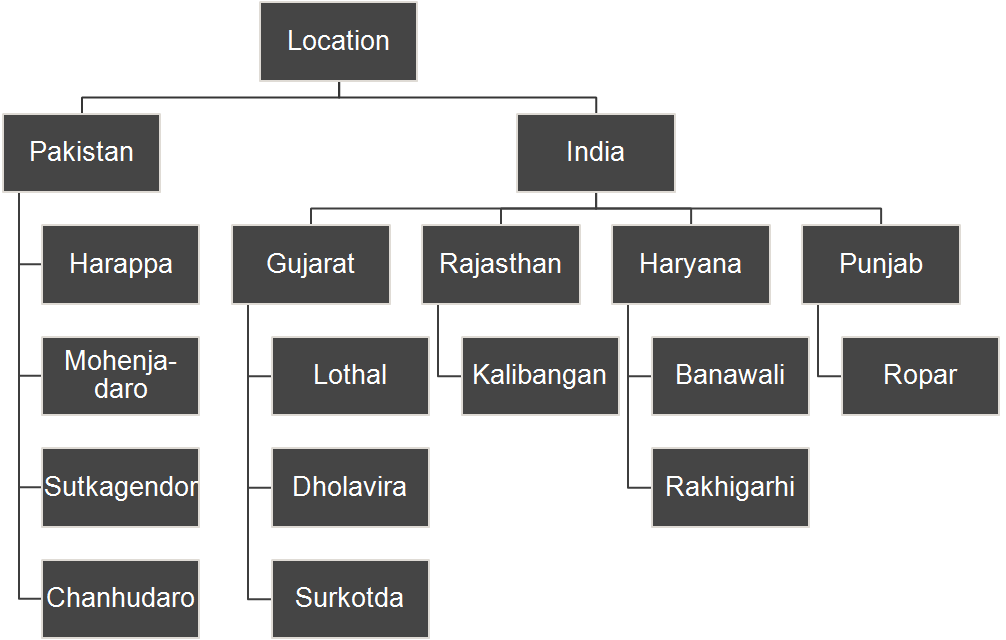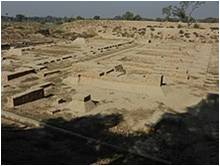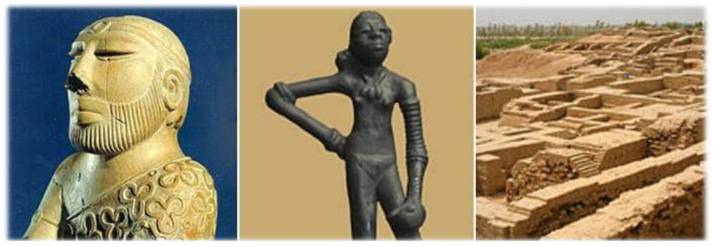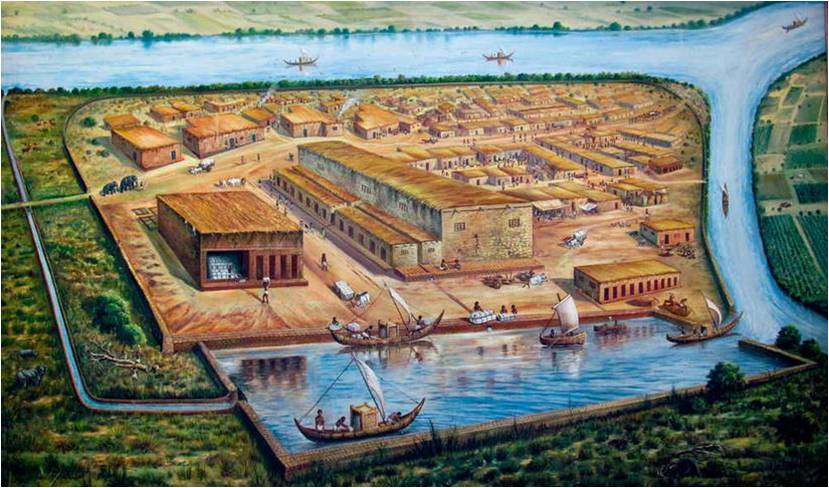MAJOR SITES of historical Importance

1. Harappa

Rediscovered by Dayaram Sahni in 1921 at Sahiwal District, Punjab in the banks of Ravi.
The site of the ancient city contains the ruins of a Bronze Age fortified city, which was part of the Indus Valley Civilization centered in Sindh and the Punjab, and then the Cemetery H culture.[The city is believed to have had as many as 23,500 residents and occupied about 150 hectares (370 acres).
The ancient city of Harappa was heavily damaged under British rule, when bricks from the ruins were used as track ballast in the construction of the Lahore–Multan Railway.
The Great Granary measuring 1 69 ft x 3 5 feet is the largest and the most remarkable structure found at Harappa.
So far 891 seals have been recovered from Harappa, and that is 40% of the total number of seals belonging to Indus Valley Civilization that have been found.
A red sandstone naked male torso has been found,
Between the granary and the citadel, have also been found a series of circular platforms, probably for the pounding of grain
At a lower level below the granary, platforms and the citadel were crowded one-room dwellings, which suggest slave habitats.
- Piece of Pottery with Indus Script
- Cubical Limestone Weight
- Faience Slag
- Sandstone statues of Human anatomy
- Copper Bullock cart
- Granaries
- Coffin burials (Only founded in Harappa)
- Terracotta Figurines
- Cemetery H & R37.
2. Mohenjo-Daro

Mohenjo-Daro was rediscovered by R.D Banerjee in 1922.
Mohenjo-Daro is located off the right (west) bank of the lowerIndus river in Larkana District, Sindh, Pakistan.
In Sindhi language, the word Mohenjodaro means mound of the dead’.
It is the largest of all Indus cities
The Great Bath is the most important public place, measuring 39 feet (length) X 23 feet (breadth) X 8 feet (depth). Located at the center of the citadel, it is remarkable for beautiful brickwork Its floor is made of burnt bricks set in gypsum and mortar. It must have served as a ritual-bathing site
Remains have been found of an oblong multi-pillared assembly hall and a big rectangular building, which must have served administrative purposes.
Most of Mohenjo-Daro houses are built of kiln-fired brick
The major streets are 33 feet wide and run north-south, intersecting subordinate ones, running east-west at right angles.
The evidence of Indian ships (figured on a seal) and a piece of woven cloth has been discovered from here
There is a large granary consisting of podium of square blocks of burnt-bricks with a wooden superstructure
Parallel rows of two-roomed cottages found The workmen or poor sections Of the society perhaps used these cottages
A bronze dancing girl, steatite statue of a priest and a seal bearing Pashupati have been found here
It is important to remember that Mohenjo-Daro shows nine levels of occupation towering over 300 feet above the present flood plain
Excavation reveals that the city was flooded More than seven times
- Prepared Garments.
- Temple-like Palace.
- Pashupati seal.
- Statue of a dancing girl.
- Ivory weight balance.
- The Great Bath.
- The Great Granary.
- Priest-king statue.
3. KALIBANGAN
Kalibangan site is located at Hanumangarh District, Rajasthan on the bank of Ghaggar river.
Discovered by Amlanand Ghose in 1953.
Kalibangan name translates to “black bangles” (“Kālā”, in Hindi, means black and “bangan” means bangles). A few miles downstream is the railway station and township named Pilibangā, which means Yellow Bangles.
ASI set up a Archaeological Museumat Kālibangan in 1983 to store the excavated materials here during 1961–69. In one gallery, Pre-Harappan finds are displayed, while Harappan finds are displayed in the other two galleries.
Has pre-Harappan as well as Harappan cultural phases.
Less developed compared to Mohenjo-Daro
There is evidence of mud-brick fortification
Pre-Harappan phase here shows that the fields were ploughed unlike the Harappan period.
Archaeologists have discovered two platforms (within the citadel) with fire altars suggesting the practice of cult sacrifice
The existence of wheel conveyance is proved by a cartwheel having a single hub
- Lower fortified town.
- Fire Altar.
- Boustrophedon style.
- Wooden drainage.
- Copper Ox.
- Evidence of earthquake.
- Wooden plough.
- Camel’s bone.
4. Lothal

Lothal was one of the southernmost sites of the ancient Indus Valley Civilization,located in the Bhāl region of the modern state of Gujarat on Bhogva river near the Gulf of Cambay.
Discovered by S. R Rao in 1957.
Lothal was a vital and thriving trade centre in ancient times, with its trade of beads, gemsand valuable ornaments reaching the far corners of West Asia and Africa. The techniques and tools they pioneered for bead-making and in metallurgyhave stood the test of time for over 4000 years.
The Lothal site was nominated, in April 2014, as a UNESCO World Heritage Site, and its application is pending on the tentative list of UNESCO
Only Indus site with an artificial brick dockyard. It must have served as the main seaport of the Indus people It was surrounded by a massive brick wall, probably as flood protection.
Lothal has evidence for the earliest cultivation of rice (1800 BC) The only other Indus site where rice husk has been found is Rangpur near Ahmedabad.
Fire altars, indicating the probable existence of a fire cult, have been found
A doubtful terracotta figurine of horse is found here.
- Port Town
- Graveyard
- Ivory weight balance
- Copper dog
- First manmade port
- Dockyard
- Rice husk
- Fire alters
- Chess-playing
5. Dholavira


Dholavira is an archaeological site at Khadirbetof Kutch District, in the state of Gujarat discovered by RS Bisht in 1985.
Dholavira’s location is on the Tropic of Cancer. It is one of the five largest Harappan sites and most prominent archaeological sites in India belonging to the Indus Valley Civilization. It is also considered as having been the grandest of cities of its time.
The other Harappan towns were divided into two parts — Citadel and the Lower Town, but Dholavira was divided into three principal divisions, two of which were strongly protected by rectangular fortifications.
There are two inner enclosures — the first one hemmed in the citadel (which probably housed the highest authority)and the second one protected the middle town (meant for the close relatives of the rulers and other officials).
The existence of this middle town, apart from the lower town, is the real exclusive feature of this city.
Dholavira is the sophisticated water conservation systemof channels and reservoirs, the earliest found anywhere in the world,built completely of stone.
- Only site to be divided into three parts.
- Giant water reservoir.
- Unique water harnessing system.
- Dams.
- Embankments.
- A stadium.
- Rock – cut architecture.
6. Surkotada
Surkotadais an archaeologicalsite located at Kutch district, Gujarat, India which belongs to the Indus Valley Civilisation (IVC). It is a smaller fortified IVC site with 1.4 hectares (3.5 acres) in area.
Discovered by J.P Joshi in 1964.
It is the only Indus site where the remains of a horse have actually been found.
Stone covered grave
7. Chanhudaro
Chanhu-darois an archaeological site belonging to the Indus Valley Civilization. The site is located 130 kilometers south of Mohenjo-Daro, in Sindh, Pakistan. The settlement was inhabited between 4000 and 1700 BCE, and is considered to have been a center for manufacturing carnelian beads.
It was first excavated by N. Majmudar in 1931.
Only Indus city without a citadel.
Existence of Pre-Harappan as well as Harappan cultural phase v
A small pot was discovered here, which was probably an ink pot
The city was twice destroyed by inundations. Here more extensive but indirect evidence of super-imposition of a barbarian lifestyle is seen.
The footprint of a dog chasing a cat
Carts with a seated driver.
8. Ropar (Rupnagar)
Roparis a city and a municipal council in Rupnagar district in the Indian state of Punjab
Rupnagar is one of the Indus Valley sites along the Ghaggar-Hakrabeds. There is an Archaeological Museum in the city which was opened in the year 1998 for general public. The museum exhibits the archaeological remains of excavated site in the city, the first Harappan site of Independent India.
The excavations have yielded five-fold sequence of cultures — Harappan, PGW, NBP, Kushana-Gupta and Medieval.
The evidence of burying a dog below the human burial is very interesting
Oval pit burials
9. Banawali
Banawali is an archaeological site belonging to Indus Valley Civilization period in Fatehabad district, Haryana, India and is located about 120 km northeast of Kalibangan and 16 km from Fatehabad.
It was excavated by RS Bisht in 1974.
Like Kalibangan, Amri, Kot Diji and Harappa, Banwali also saw two cultural phases – pre-Harappan and Harappan.
Human and animal figures, clay bangles and statue of mother Goddess found here.
Here we find large quantity of barely, sesame and mustard.
10. Sutkagendor
Located at Baluchistan on Dast river in Pakistan, excavated by Stelin in 1929
Trade point between Harappa and Babylon
Flint Blades
Stone Vessels
Stone Arrowheads
Shell Beads
Pottery
Bactria-Margiana Archaeological Complex (BMAC) associated Copper-Bronze Disc
11. Rakhigarhi
Rakhigarhior Rakhi Garhiis a village, nearby Hisar city and an archaeological site belonging to the Indus Valley Civilisation in Hisar District of the northern Indian state of Haryana, situated about 150 km northwest of New Delhi.
It was among the largest settlements of the ancient civilisation, though most of it remains unexcavated.
The site is located in the Ghaggar-Hakra River plain,some 27 km from the seasonal Ghaggar river.
The site was first excavated by the Archaeological Survey of India (ASI) in 1998-2001. Later, Deccan College, Pune, excavated the site from 2013 to 2016.
The skeleton of male (code named as 11A), part of the “Rakhigarhi love birds” couple, with his skull facing towards female (code named as 11B, not seen in the picture) found at Rakhigarhi and now on display in the National Museum.
Rakhigarhi in news 2022
The latest round of excavations revealed the structure of some houses, lanes and drainage systems, and a jewelry-making unit. Pieces of copper, gold jewelry, terracotta toys, earthen pots, and seals were also found.
This is the first time excavations have been done on Mound No. 3 out of 11, which has revealed “an aristocratic settlement”.
An agreement is in process between the Archaeological Survey of India (ASI) and the Haryana government. As per the agreement, antiquities from Rakhigarhi will be displayed at the adjacent under-construction museum being built by Haryana for Rs 23 crore.
Rakhigarhi is among the five iconic sites announced by Union Finance Minister Nirmala Sitharaman during her Budget Speech in February 2020.
The other iconic sites are Hastinapur in Uttar Pradesh, Sivasagar in Assam, Dholavira in Gujarat, and Adichanallur in Tamil Nadu.








No comment